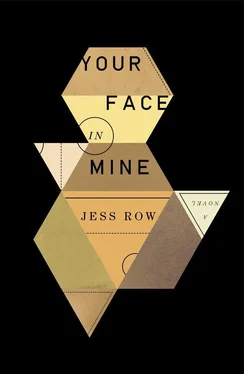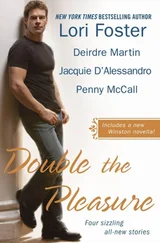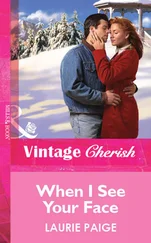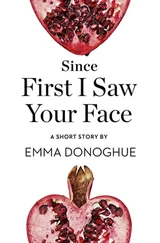Now, an adult again, I heave myself out of the water, checking to make sure my Downtown Athletic Club guest pass is still attached to my swimsuit, and the bored attendant — a short Latina in a black track suit, who looks too young even to have graduated from high school — leaves off texting long enough to hand me a thick, fleecy towel. I’ve finished as many laps as I can stand; swimming for exercise — really, any kind of repetitive exercise — bores me to death. What I love about water is being able to slip into it and cut the world off, sealing that membrane of silence. Maybe I was one of those babies who never wanted to leave the womb.
Is it always this quiet in the middle of the day? I ask her.
Nah. Not always. Sometimes there’s conventions. But otherwise, I don’t know, I guess people have to work .
I dry my face, my neck, and work downward, scrubbing my flaccid, untoned arms, my knobby chest with its spray of moles, its odd patches of hair. I haven’t been in a pool — haven’t been in public, in a bathing suit — in the seven months since August. And like all people of my complexion, who live in northern climes, whose skin barely sees the sun eight months of the year, I’ve turned the color of white wax or lake ice, the color of an eye clouded by glaucoma.
Martin, in the next lane, hasn’t stopped once in twenty minutes. He alternates between freestyle and breaststroke, dipping and ducking his head like an efficient waterbird. I wouldn’t call him a natural swimmer — he scissor kicks, and doesn’t keep his line straight, veering across into the left side of the lane — but he compensates with stamina. You can see it in his exaggerated shoulders, his fistlike calves. If you weren’t here, he told me, I’d go for an hour without a break. It’s the only way I can think.
In my bag is the manila folder he handed me as we walked in. Some notes I started taking about a year ago, he said. Thought I’d write a book. Anyway, it might be a place to start. Or it might be pure bullshit.
I dry my hands carefully and open the folder. Ten pages, stapled, like a high school term paper, with his name in the upper left-hand corner.
ON RACIAL IDENTITY DYSPHORIA SYNDROME (RIDS): A SELF-DIAGNOSIS
This paper is offered as an attempt to open up dialogue about one of the major overlooked mental phenomena of our time. I offer it as a personal reflection and an appeal for scientific and pharmaceutical research into this urgent issue.
I have the physical appearance of an African American male. In seven years of living with this appearance, it has never been questioned or found unusual by any of my friends or my intimate partners, including my wife of four years, who is also African American. However, this appearance is based on a carefully created medical procedure that was carried out in Bangkok, Thailand, in 2001–2, by Dr. Binpheloung Silpasuvan and his medical associates. Specifically, Dr. Silpasuvan carried out a series of facial surgeries, scalp surgeries, body-sculpting procedures, and pigmentation treatments, transforming me from my original appearance as a Caucasian-Jewish “white” male into a convincing African American. I returned to the United States with an altered passport and have since presented myself as the child of adoptive white parents, now dead, with no information about my biological roots. This is the story that everyone around me — my wife, my intimate friends, my pastor — takes at face value.
Those are the scientific facts, shocking as they may be. What is even more shocking is the syndrome that drove me to this extreme, costly, and risky decision. I discovered, in my early adulthood (I was twenty-eight at the time of the procedure), that my long history of psychological problems, including depression, agoraphobia, and involvement in illegal activities, was the result of being born in the wrong physical body. I term this “racial identity dysphoria” because I believe it is in many ways similar to the gender dysphoria that is so commonly reported in the news.
What justifies my belief that I was in fact born in the wrong race, as transsexuals claim to be born in the wrong sex? Some will surely believe that this is nothing more than a publicity stunt, or perhaps a perverse expression of “white guilt.” The first charge, I believe, is answered by the fact that I have kept my true identity a secret for so long, and that until now I have made no effort to “go public.”
Guilt just did not enter into it. Not then, not now. I never felt that it was “bad” or “wrong” to be a white person or a Jew. Of course, I was aware of the history of slavery, the civil rights movement, apartheid, job discrimination, and so on; but I was never led to feel a sense of responsibility or even involvement in the history of black people in America. My father, my only surviving family member (my mother died when I was an infant; he is now also deceased, as of 1995), was a profoundly self-absorbed person, a historian, an archivist, who had very little interest in contemporary society at all. I grew up around black people and have had black friends for as long as I could remember, but I was not, to any great degree, ever made fun of, isolated, mocked, or bullied for being white. In other words, my dysphoria cannot be associated with some trauma, some discreet, explicable, psychological cause, at least not one I can identify. Transsexuals are usually given a battery of tests before they undergo sex-change procedures. Were there to be such a test for racial reassignment surgery, I believe I would pass it.
What I can say is that I always (until the moment my bandages were taken off) knew in some way that I lived in the wrong body. I’ve spoken with transsexuals (in fact, I came to know a few of them during my time in Thailand, as they are Dr. Silpasuvan’s primary base of customers) who’ve told me exactly the same thing. There is an inchoate sense in which something is wrong long before there is a sense of what could be done to make it right.
It helped (you could say, in a sense at least) that I did not grow up in a judgmental family or a family that really was very interested in my appearance or what I might do to modify it. I never experienced any pressure to dress a certain way or live up to a certain kind of social appearance. In fact, whether or not I put on clothes in the morning was almost entirely up to me. Furthermore, beginning in my early teenage years, I existed in a social milieu that, to put it bluntly, tolerated, even encouraged, freaks.
You might have thought that this atmosphere of social liberty (some might even call it neglect) would have led me to radically alter my appearance in the conventional ways, by dyeing my hair, for example, or getting piercings or tattoos. I never had any appetite for such things. In fact, I dressed in a monotonous, unimaginative way, barely keeping enough clothes around to make it from week to week. I lived inside a cocoon, one could say, poetically, I suppose, waiting for the real change to happen.
It was the suicide of my best friend in the spring of 1993 that caused me to radically rethink the course of my life—
I fold the pages back, quickly, abruptly, and replace them as they were in my bag. Martin is as he was, churning through his daily mile, flashing me the happy grimace of the endorphin addict. My ears fill up with the silence, the ambient non-noise, of all this empty space: lapping water, humming ventilation fans, low, indistinct Muzak, the attendant’s flip-flops slapping the tiles as she paces back and forth, waiting to hand out her second towel of the morning. Expensive silence. How much money, it occurs to me just now, we spend to create these sterile bubbles, these vacuums abhorred by nature. How much money Martin spent; and now he wants to be the first with the brick, the needle, to let the pressure out, to let the world come roaring in? It makes no sense; it makes perfect sense. Look what I’ve made, he’s saying to me, through the stinging chlorinated air. I made this. I made this.
Читать дальше












